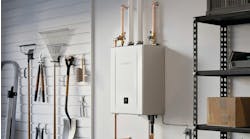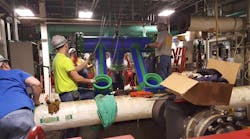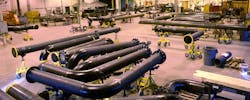Latest from Piping
Sponsored
LAWRENCE, KANSAS — Injection molding is a manufacturing process that works at high volumes and high speeds. A mere half-second loss in production time can cost an injection-molding facility thousands of dollars.
Jacob Francis, facility maintenance supervisor at Berry Global, was facing huge losses when he recognized the need to replace a large portion of the carbon-steel pipe used to transport cooling water to more than 20 injection-mold and thermoforming machines.
The plant in Lawrence, one of Berry Global’s 130 facilities around the world, produces food-grade plastic cups and containers. The system is simple: water leaves the chiller at 55°F and flows to the injection-molding equipment. Water exits through orifices in the aluminum or steel molds and circulates to a holding tank before returning to the chiller.
Cooling the molds is a critical, time-sensitive part of the injection-molding process; the plant already had begun to incur losses because rust and pipe scale were interfering with the cool-water flushing. “Our [cooling] cycle time on some of the equipment had increased due to hot cores. This resulted in significant losses in production,” Francis said.
According to Francis, at the required 3,800 GPM, the water never had an opportunity to “settle,” causing air to be absorbed within the system. The aerated system not only was rusting badly, but the excessive air also prevented water-treatment chemicals from adhering to and protecting the carbon-steel pipe effectively. Corrosion already had eaten two holes in the (undersized) 4,000-gallon chilled-water tank.
The situation would only get worse until the piping was replaced, but that created an even greater challenge: How do you replace 300 ft. of 10- and 16-inch welded steel pipe for a manufacturing process that virtually never stops?
The plant operates 24/7 every single day of the year, save a day or two at Thanksgiving and Christmas. Shutting down operations for just one hour comes at a high price to large injection-molding manufacturers like Berry, a price they most certainly would have to pay several times over if the piping was replaced with field-welded carbon steel.
The installation included the construction of a new 10,400-gallon outdoor chilled-water tank, 16-inch supply and return piping to and from the tank, and assorted lengths of 12- and 10-inch piping connecting a 16-inch PP-R header.
Todd Mihalchik, industrial mechanical estimator and project manager for P1 Group in Lawrence, Kansas, an MCAA member and the mechanical contractor selected for the piping renovation, had another thought: Aquatherm PP-R piping systems. PP-R pipe components are joined using a safe, rapid, heat-fusion process. For a 16-in. pipe, connection time can take as little as 47 minutes.
P1 Group has a history dating all the way back to 1919 when it was AD Jacobson Co. In 1997, it became part of a holding company for five separate entities, each with its own field of expertise, be it plumbing or electrical; construction, commissioning or service. In 2007, they were consolidated as a single company and took the new name from their slogan: The Expertise of Many, the Power of One.
Even though no one from P1 Group previously had installed Aquatherm pipe in such large diameters, Mihalchik’s conversations with local representatives from the Lawrence branch of Ferguson Enterprises convinced him that the piping might be the answer for his longtime client.
Caught between a costly shutdown and a rapidly deteriorating system, Francis agreed to listen to presentations from Aquatherm and was finally convinced. Francis gave P1 Group the green light to install Aquatherm Blue Pipe to replace the chilled-water piping serving two-thirds of the plant’s injection-molding processes.
At a training session held just prior to the Berry project, installation specialists Aquatherm Regional Sales Manager Mike Engle and Ferguson Enterprises’ Nathan Geyer taught P1 Group technicians the appropriate heat-fusion procedures. Heat fusion works by returning the connection point to a melted state, the way it was during production. This allows the polypropylene chains to join together as the connection cools for a permanent bond, as if they were manufactured as one piece.
“About five or six of our installers attended the five-hour course taught by Aquatherm where they learned all the different heat-fusion welding techniques,” Mihalchik said.
The installation included the construction of a new 10,400-gallon outdoor chilled-water tank, 16-inch supply and return piping to and from the tank, and assorted lengths of 12- and 10-inch piping connecting a 16-inch PP-R header to the various injection-mold presses.
In-shop pipe fabrication was an important part of the time-saving strategy. P1 Group is a charter member of the Pipe Fabrication Institute and has made fabrication a key part of the company’s services. P1 Group has a full-service, state-of-the-art pipe fabrication facility in Lawrence that serves clients across the country. The facility includes the latest in pipe fabrication technology and about 35,000 square feet of working space.
Nearly all the piping sections were fabricated in advance at P1’s facility, then installed using rented Widos butt-welding equipment as well as a McElroy Spider and McElroy handheld socket-fusion equipment. The only exception was the 16-in. header, which Aquatherm’s Design & Fabrication Services team fabricated because P1 Group did not have ready access to the welding equipment needed for the large-diameter pipe.
The fabricated piping sections — some of which were 15 ft. — were lightweight enough for just two men to carry into the installation space and hoist into place. This was a huge advantage for P1 Group, given the project’s ever-shrinking installation window.
“At first, we were going to have three days for the actual installation, but that got whittled down to just 24 hours on Good Friday before Easter. The timeframe was really challenging, but Aquatherm made things a lot easier,” Mihalchik said.
The only glitch, which occurred during the all-night installation, turned into a blessing for Mihalchik and his crew. At one point, the installers discovered that two of the 10-inch lines off the 16-inch header had been cut too short. It might have been a panic-inducing discovery if not for Engle, Geyer, and Ferguson Enterprises’ Kent Cramer who were at the jobsite during the installation and able to oversee some impromptu pipe fusion to adjust the length of the 10-inch pipe.
“They showed us how easy a fix it really was. In a way, it was a fortunate mistake because now we know we can work through it easily on our own,” Mihalchik said.
“The fact that we didn’t have to insulate the pipe is another huge benefit. None of the indoor pipe had to have any insulation, even though we are carrying 55°F water in an 80°F ambient space,” Francis said.
Francis added that despite some extremely warm, humid days since the pipe was installed, he has yet to see a drop of condensation on the pipe.
“I have one flange where carbon-steel pipe meets the Aquatherm. I can put a hand on each and feel that the Aquatherm is barely below room temperature while the carbon-steel pipe is really cold,” Francis said.
The plant already has seen improvements in system performance, both in terms of chiller usage and pump efficiency. Perhaps even more important, the Berry plant has eliminated future downtime caused by pipe corrosion — at least where the PP-R pipe is installed. Furthermore, the company has all but eliminated the need for chemical treatment in its piping system.
And P1 Group has been hired on to perform the next phase of repair and replacement. And when is the work scheduled for? “Christmas and Thanksgiving,” Mihalchik said. “It’s the only downtime they have!”



